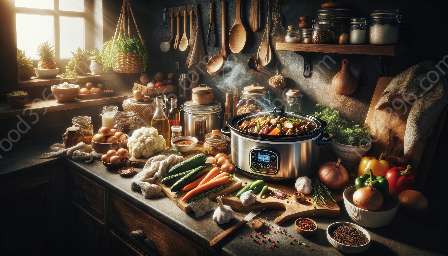Braising is a cooking method appreciated for its ability to transform tough cuts of meat and sturdy vegetables into tender, flavorful dishes. As a key slow cooking technique, braising involves searing the food at high heat and then slowly cooking it in a covered pot with a small amount of liquid.
When it comes to food preparation techniques, braising is a beautiful marriage of tenderizing, flavor intensification, and moisture retention. This topic cluster will explore the art of braising, its compatibility with slow cooking, and essential food preparation techniques.
Braising: A Slow-cooking Method
Braising entails cooking food in a covered vessel with a small amount of liquid at low heat for an extended period. It is considered a slow cooking method due to the prolonged cooking time, typically done at low temperatures, which allows the flavors to meld together and the connective tissues in the ingredients to break down, resulting in a fork-tender texture.
One of the key elements of braising is the use of flavorful liquids, such as broth, wine, or a combination of both. These liquids infuse the food with depth and richness as they slowly simmer, creating a sumptuous sauce or jus.
Slow Cooking and Braising: Complementary Techniques
Braising and slow cooking go hand in hand, as both methods involve gentle, low-temperature cooking for an extended period. Slow cookers, Dutch ovens, and pressure cookers are commonly used vessels for both slow cooking and braising, making them versatile tools for home cooks and professional chefs alike.
While slow cooking often involves cooking the food over a longer period without necessarily involving pre-searing, braising incorporates the step of searing the ingredients at high heat before the slow cooking process. This initial step caramelizes the surface of the food, adding complexity and depth of flavor to the end result.
Furthermore, both slow cooking and braising are known for their ability to turn inexpensive, tough cuts of meat into luscious, succulent dishes. Whether it's beef chuck, pork shoulder, or lamb shanks, these tougher cuts benefit greatly from the low and slow cooking process, resulting in dishes that are both economical and deeply satisfying.
Food Preparation Techniques for Successful Braising
Successful braising requires attention to detail and understanding of fundamental food preparation techniques. The following are key tips for achieving successful braised dishes:
- 1. Searing: Searing the meat or vegetables before braising is crucial for creating a caramelized outer layer and developing rich, deep flavors. Use high heat and a touch of oil to achieve a golden-brown crust.
- 2. Flavorful Liquids: Choose liquids with robust flavors, such as stock, wine, or a combination of both, to braise your ingredients. These liquids will infuse the dish with complexity and depth of taste.
- 3. Aromatics and Vegetables: Incorporate aromatics like onions, garlic, and carrots, as well as hearty vegetables like potatoes and root vegetables, to enhance the flavor profile of the braised dish.
- 4. Proper Seasoning: Season the ingredients generously with salt, pepper, and any other desired herbs and spices to ensure a well-seasoned final dish.
- 5. Low and Slow Cooking: Remember to keep the heat low and the cooking time long to allow the flavors to meld and the connective tissues to break down, resulting in tender, succulent dishes.
Conclusion
Braising is a culinary artform that brings out the best in a variety of ingredients, from meats to vegetables. Its compatibility with slow cooking and emphasis on food preparation techniques make it a valuable skill for any cook looking to create deeply flavorful and tender dishes. By mastering the art of braising, one can elevate humble ingredients into extraordinary culinary creations.

